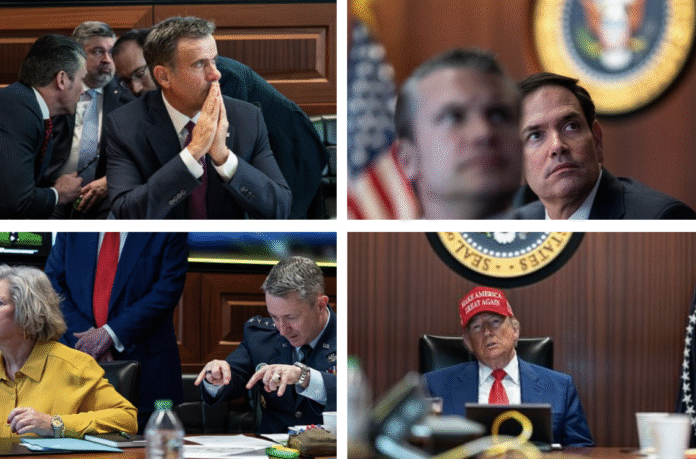Key Point Summary – Trump’s Situation Room Strike
- Photos reveal Trump’s inner circle during Iran strike
- Mission used bunker busters and Tomahawks
- Fordow, Natanz, and Isfahan sites destroyed
- JD Vance, Rubio, Wiles, Hegseth, and Gabbard present
- Trump wore MAGA “45–47” hat during the call
- CIA, Pentagon, and military chiefs flanked the president
- Public reactions range from praise to outrage
Secrets Unveiled From Inside The Situation Room
On June 21, 2025, President Donald Trump made history—and war—from deep inside the White House. With the world watching for diplomacy, Trump gave the green light to obliterate three of Iran’s most fortified nuclear sites.
Late Saturday evening, the White House shocked the public again—this time with photos. Snapped inside the Situation Room, the images showed Trump surrounded by his most trusted allies. The same faces that helped orchestrate one of the most dramatic U.S. military strikes in decades.
Trump’s now-iconic red MAGA hat, embroidered with “45-47,” sat firmly on his head as he delivered the order. The mood in the room? Calm, focused, and deadly serious.
Trump’s Team At Ground Zero Of Decision
Alongside the president were Vice President JD Vance and Secretary of State Marco Rubio. Chief of Staff Susie Wiles stood nearby, shoulder to shoulder with CIA Director John Ratcliffe. General Dan Caine, Chairman of the Joint Chiefs, and Defense Secretary Pete Hegseth filled out the war table.
One notable absence in the photos: Director of National Intelligence Tulsi Gabbard. She was reportedly present but did not appear in the images released to the public.
What followed next was pure shock and awe.
Bunker Busters And Blistering Bombs
Just before 8 p.m., Trump took to Truth Social. “We have successfully struck Fordow, Natanz, and Esfahan,” he wrote. “Total obliteration.”
He wasn’t exaggerating.
The operation relied on six B-2 stealth bombers and 30 Tomahawk cruise missiles. Targets included underground uranium enrichment sites buried beneath mountains of reinforced concrete.
The Fordow facility—previously believed to be impenetrable—was flattened with 30,000-pound bombs designed to punch through bunkers. Natanz and Isfahan followed.
Trump later addressed the nation, calling the operation “a spectacular military success.” The damage, he claimed, was total. The message to Iran? Choose peace or face the next wave.
‘God Bless Our Military,’ Trump Says
During his address, Trump praised the U.S. Air Force and B-52 pilots who delivered the crushing blow. He thanked Israeli Prime Minister Benjamin Netanyahu for “standing with America in defense of the free world.”
Defense Secretary Pete Hegseth, a former Fox News personality and military veteran, stood behind Trump during the speech—though he had to shuffle mid-way to get into camera view.
Trump was also flanked by Secretary Rubio and VP Vance. All three men remained stoic as Trump warned Iran: “There will be more. But peace is better.”
A Prayer, A Warning, A Promise
In a rare spiritual moment, Trump ended his speech by saying, “We love you, God. And we love our great military—protect them.”
He then handed the spotlight to General Caine and Hegseth, who are set to brief reporters in an early morning Pentagon session.
It was a stunning close to a day filled with deception, strategy, and sheer force.
Photos of the Situation Room circulated rapidly online. Each image sparked fresh questions—and strong reactions.
The Internet Reacts With Fire And Fury
Within minutes, Trump’s war room photos went viral.
Conservatives hailed the images as proof of strength. “This is what leadership looks like,” one supporter wrote on X. “No teleprompters. Just guts.”
But critics were just as vocal. “He played God,” another user wrote. “He faked a delay, then started a war.”
Protests erupted across the country. In Chicago, demonstrators flooded Michigan Avenue. In Los Angeles, activists projected anti-war messages onto city buildings. Many demanded congressional approval—something Trump didn’t seek.
Despite the outrage, Trump’s base appeared energized. Polling overnight showed a 6-point bump in his approval among Republican voters.
Tehran Fumes, Israel Braces
Iran has yet to officially confirm the damage. But state media called Trump “a lawless bully” and promised retaliation.
Israel, meanwhile, braced for a possible counterattack. Its missile defense systems were placed on high alert. Prime Minister Netanyahu reportedly called Trump within minutes of the strike’s confirmation.
Iran’s foreign minister condemned the attack, warning, “The fire lit by America will not stop at our borders.”
Military Chiefs Ready For Next Steps
While Trump basks in the aftermath of what he calls “an overwhelming success,” the Pentagon prepares for escalation.
Both Hegseth and General Caine are expected to offer detailed assessments at Sunday’s 8 a.m. briefing. Topics will include battle damage reports, casualty figures (reportedly zero on the U.S. side), and intelligence projections.
Meanwhile, CIA Director John Ratcliffe, visible in the Situation Room photos, is reportedly briefing global allies on the classified intel that led to the strike.
Sources close to the administration say Trump approved the strike only after confirming Iran’s nuclear sites had resumed high-grade uranium enrichment, in violation of international agreements.
A Flash Of War, A Plea For Peace
Trump’s message to Tehran remains blunt: Submit or be struck again.
“Our objective was the destruction of Iran’s nuclear enrichment capacity,” Trump said. “Tonight, I can report to the world that we achieved that goal.”
But he also extended a controversial olive branch.
“We are ready for peace—if they are. But if they’re not, America is more than ready.”
The World Watches, The Room Stays Silent
Back in the Situation Room, the expressions on each official’s face told its own story.
Determination. Tension. Resolve.
The war council had executed a military operation unlike any in recent history. And now, they wait.
What happens next is anyone’s guess. But one thing is clear—Trump is betting that strength, secrecy, and surprise will lead the way to victory.
Or war.
Either way, the world just got a front-row seat to what power really looks like behind closed doors.




